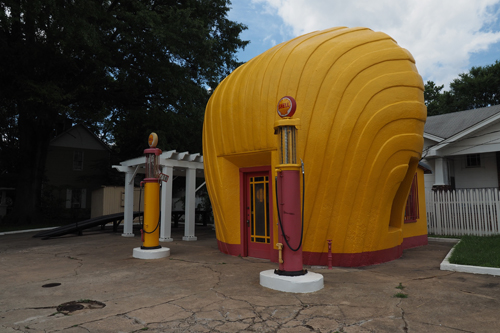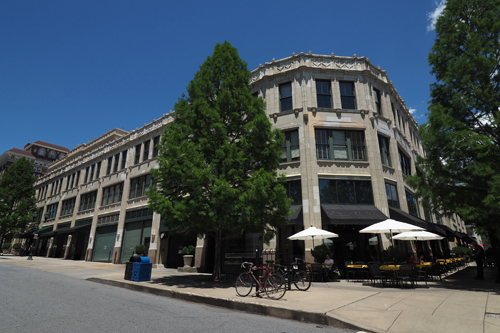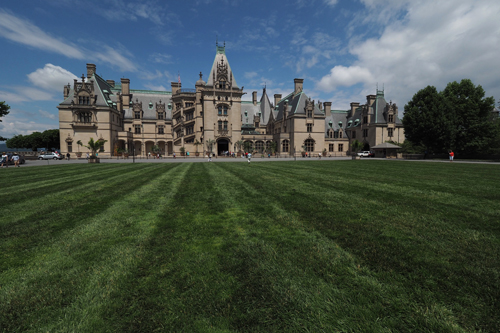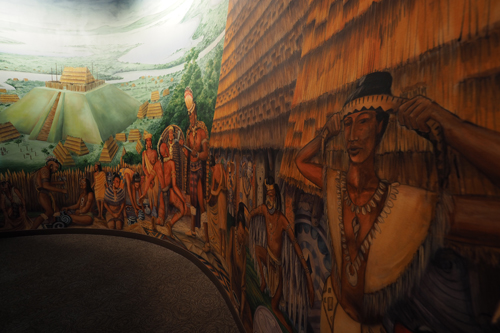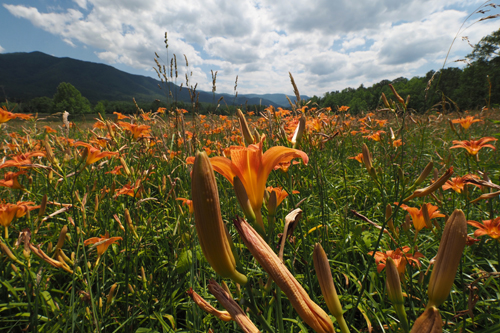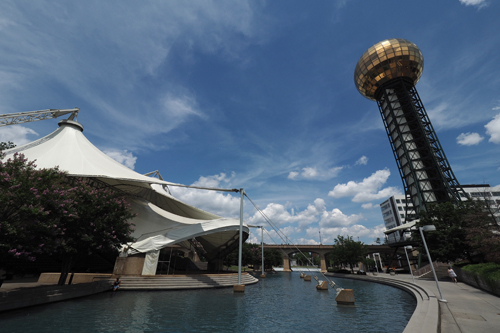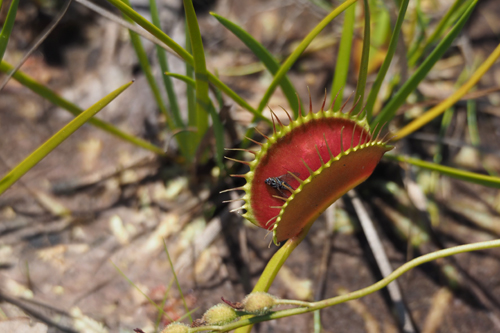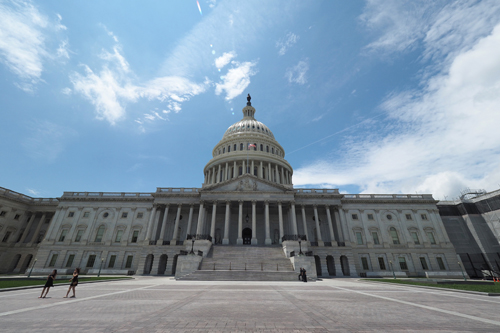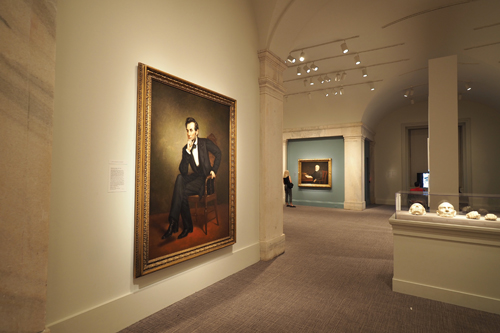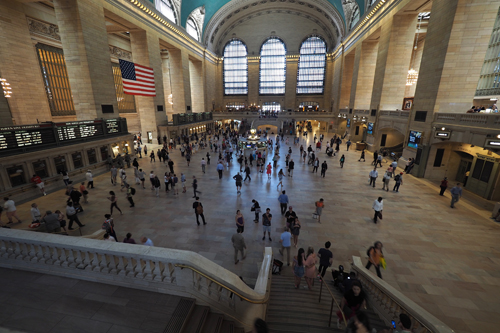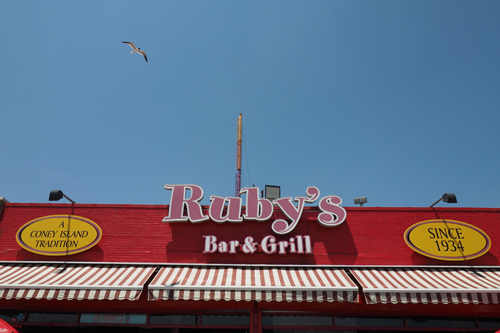June 5, 2017. Roanoke, Virginia to Winston-Salem, North Carolina.
The sky was dark and foreboding on the morning we left Roanoke and the rain had returned. Our plan was to drive along the Blue Ridge Parkway, continuing our journey in the eastern states.
We stuck to the plan but didn’t get out of the car as the weather was too foul.
One stop we did make was at Mabry Mill. Built in 1910 this was a multipurpose mill that not only ground corn but was also a sawmill and a woodworking shop.
We continued our drive into Winston-Salem.
The further south we moved, the better the weather became and by the time we reached the hotel the rain had stopped completely.
There were still some very dark clouds clinging to the horizon.
Winston-Salem has a population of nearly a quarter of a million people, so it’s a lot larger than we have been used to.
It is a ‘Twin City’ due to its duel heritage. It is also know as ‘Camel City’ because of the locally based tobacco company RJ Reynolds.
Salem is the older part of the two cities, first being settled in 1753 by Bishop August Spangenber and his followers on behalf of the Moravian Church.
In 1849 the Salem congregation sold some land to the north, this then became Winston in 1851.
Winston was a sleepy country town until Pleasant Henderson Hanes, his brother John Wesley Hanes and Richard Joshua Reynolds built their tobacco factories there in the 1870s. By the 1880s there were almost 40 tobacco factories in the town of Winston.
The Hanes brothers and Reynolds were fierce competitors for the next 25 years until in 1900 when Pleasant Henderson and John Wesley Hanes sold out to Reynolds. They then built a second life in textiles.
This became the famous Hanes underwear and hosiery company.
That evening we caught an Uber up to the Foothills Brewing Company for dinner.
The rain had started again so walking was out of the question, even though it was very close to our hotel.
The food, wine and beer were excellent. There was also a great display of their ‘Retro’ posters on the walls around the dining area.
This was a brewpub in the old tradition. The waitstaff grovelled for tips, unlike their counterparts in the west and north central parts of the US.
After some discussion with the wait staff we discovered that they get paid $2.30 per hour.
Why would anybody work for that?
The simple answer is – they have no choice. There are no unions, to push for better conditions and pay, and the owners are so heavily taxed that they are not making that much money.
Well that was the story we were told.
June 6, 2017. Winston-Salem, North Carolina.
‘Reynolda House Museum of American Art’ is the description that is now given to the RJ Reynolds family home in Winston-Salem.
It was the passion and brainchild of Katharine Smith Reynolds, wife of RJ Reynolds.
The house was the centre piece of a 1,067 acre (4.32 square kilometres) estate just outside of the city centre.
Today the house has one of the finest collections of American paintings spanning three centuries.
It was designed by Charles Barton Keen (1868-1931), with construction starting in 1912 and completed in 1917.
Due to it’s low profile and wide verandas it was described by Katherine Reynolds as a ‘Bungalow’
It is far from any bungalow that we know, especially the Californian style.
The Reynolda House Estate was run on the style of an English estate in the 18th and 19th century. Think Downton Abbey.
Apart from the main house there was a self-sufficient estate that was run by Katharine Smith Reynolds. This consisted of gardens, facilities for recreation, a school, church, model farm and housing for the estate workers.
A short drive from the centre of town was the shell shaped service (gas) station. This single story Shell station, in the shape of a giant scallop shell, was built by R.H. Burton and his son, Ralph, in 1930. It is located at the corner of Sprague and Peachtree Streets in Winston-Salem. The owners decided to attract customers through a series of shell-shaped service stations.
A very good example of how literal 1920s and ‘30s advertising was.
June 7, 2017. Winston-Salem to Asheville, North Carolina.
There was a lot to see and do in Asheville, so we just took the Interstate and made the trip as simple as possible.
We had been told how great Asheville was by the owner of a wine store in NYC.
She seemed to know her wines and craft beers and gave the city a great wrap, especially in regards to its off-beat culture.
We found the Visitor’s Centre and they didn’t hesitate in sending us on the ‘Asheville Urban Trail’.
This was a three hour, self-guided, walking tour of downtown.
Apart from it’s vibrant arts culture Asheville has some of the best Art Deco buildings in the US.
When most cities in the country were demolishing their ‘old’ buildings during the 60s Asheville was in a financial slump and had no plans for redevelopment.
This saved the city and preserved its heritage.
It is now one of the fastest growing regions in the country.
Asheville was incorporated in 1797 and named after Governor Samuel Ashe.
It also boasts the Basilica of St Lawrence and the Biltmore Estate.
The dome of the basilica has a span of 58 by 82 feet (18 by 25 m) and is reputed to be the largest, freestanding, elliptical dome in North America.
While we were at the Visitor’s Centre we purchased, rather expensively, tickets to the Biltmore Estate.
That was tomorrow’s adventure.
June 8, 2017. Asheville, North Carolina.
America’s largest, privately owned home, Biltmore Estate, was built by George Washington Vanderbilt in 1895.
The work began on the house in 1895 and it took 1,000 workers to complete the project. Vanderbilt not only used local labourers but international artists such as Viennese sculpture Karl Bitter and Spanish architect Rafael Guastavio..
It was modelled on the French Renaissance chateau style, with characteristically steeply pitched roofs, towers, turrets, and extensive sculptural ornamentation.
It contains 255 rooms, and 43 bathrooms, which is surprising considering that George Vanderbilt was a bachelor at the time of its construction.
The name Biltmore derives from ‘Bildt’, Vanderbilt’s ancestors’ place of origin in Holland, and ‘more’, Anglo-Saxon for open, rolling land.
Vanderbilt engaged Richard Morris Hunt to design Biltmore and Frederick Law Olmsted to landscape the 8,000 acre estate.
This was Downton Abbey, but on a grander scale.
George Vanderbilt and his wife Edith were Europhiles. They met and married in Paris in 1898.
George Vanderbilt was an extensive traveller, visiting over 25 countries and crossing the Atlantic Ocean a total of 60 times in his life.
He was an intellect, speaking three languages and having a love of art, music and science.
Biltmore Estate is a huge drawcard for the Biltmore Foundation with 1.4 million visitors in 2016 alone.
June 9, 2017. Asheville to Cherokee, North Carolina.
The main reason for going to Cherokee was to learn a little about the local Native Americans.
What made it even more rewarding was that we travelled on the Blue Ridge Parkway to get there.
This was our third time on this scenic drive and to my mind the best yet.
Due to the higher altitude, the wild flowers were still in bloom.
At the Richland Balsam Overlook, which is the highest point on the Blue Ridge Parkway we reached 6,947 feet (2,117 metres).
Blue Ridge Parkway is Americas’ longest linear park. It runs for 469 miles (755 kilometres) through Virginia and North Carolina.
Construction was started during the presidency of Franklin D. Roosevelt in 1935 – that man did so much.
Museum of the Cherokee Indians was in the centre of the the town of Cherokee.
It was an interesting display that covered the aboriginals of the region through many periods, not just the Cherokee.
It showed the development of weapons from spears and throwing sticks to bow and arrow through the Paleo, Archaic, Woodland and Mississippian Periods.
One very interesting artefact was the Atlatl or throwing stick – very similar to the Woomera.
Sequoyah was part Cherokee and in 1821 developed a written language for his people. He became know as ‘The man who made the leaves talk’
Another interesting character was the Anglo-American army officer, journalist and cartographer, Henry Timberlake (1730 or 1735 to 1765)
His memoirs published in 1765 had detailed descriptions of villages, houses, weapons and tools. All vital for anthropologists and historians when they uncovered archeological sites in the southern Appalachian region.
In May 1762 Timberlake returned to England with three Cherokee chiefs, who had expressed a desire to meet the king of England. They met King George III and had their portraits painted by Sir Joshua Reynolds.
There are copies of these in the Cherokee Museum.
Unfortunately the Museum lacked academic rigour. There weren’t the usual facts, figures, dates and timelines that normally accompany the displays.
June 10, 2017. Cherokee, North Carolina to Knoxville, Tennessee.
We found, yet another, good coffee house in Bryson City, at Mountain Perks. The best coffee seems to be had at the places that roast their own beans.
If they roast they seem to care about the quality of their coffee.
Again getting to our destination was the purpose of the drive.
We took the Great Smoky Mountain National Park road from Cherokee. This was after consulting the staff at the Visitor’s Centre.
Unfortunately we had to do a little backtracking, as we were sent down a road that turned out to be closed.
I blame the woman at the Visitor’s Centre, and the TomTom.
They both should have known better.
The road was surrounded on either side by stunning views, however it was, in parts, excruciatingly slow.
The mere glimpse of a bear or deer, however distant they were, caused the traffic to stop.
The advice we received at the Visitor’s Centre was that this trip could take between two and four hours.
They were wrong about that as well, as it took more like five hours. It was worth it as the scenery was stunning.
The Great Smoky Mountains get their name from Cherokee tradition.
They are known as ’schaconage’ or ‘blue, like smoke’ because of their natural bluish haze.
In the evening we walked into Market Square in the heart of downtown Knoxville for dinner and discovered a small slice of ‘Euroamerica’.
Market Square is a block long and surrounded by cafés, bars and restaurants – all with outdoor seating facing the square.
There are buskers, musicians and lots of weird people, just as you would find in Barcelona, Paris or Berlin.
Being settled in 1786, Knoxville was the first capital of Tennessee.
It was bitterly divided during the Civil War and was occupied by both the Confederate and Union armies.
During the 1920s the economy stagnated, but in 1982 the city hosted the World’s Fair which helped to rejuvenate it.
The Sunsphere Tower, erected for the World’s fair, dominates the city skyline.
It is a 266’ (81 metres) tall hexagonal steel truss structure with a 75’ (23 metres) gold glass sphere on top.
It’s so disco and so 80s.
June 11, 2017. Knoxville and Oak Ridge, Tennessee.
Continuing with the Euroamerican theme in Knoxville we had breakfast at the French Market Crêperie, near Market Square.
The croissant, crêpes and coffee were very French, however everything was served on disposable plates and cups – very American.
After breakfast we wandered around Knoxville, it was Sunday and very quiet. I think we were the only tourists in town.
Like so many of the small towns and cities we have see, Knoxville has a mixture of 19th century and early 20th century architecture.
Some of the Art Deco buildings are fantastic and many are now being restored.
Modern architecture is hard to find. There are some contemporary office blocks, but no domestic buildings.
All houses, motels and hotels seem to hark back to the 17th, 18th and 19th century for their designs. Most are in timber and have a gabled roof.
It’s easy to see why Frank Lloyd Wright is so revered.
I discovered a website that was devoted to domestic American architecture. It was titled, American Home Styles, 1600 to Today.
It covered the following styles:
American Colonial House Styles 1600s – 1800
Neoclassical House Styles 1780 – 1860
Victorian House Styles 1840 – 1900
The Gilded Age 1880 – 1929
Frank Lloyd Wright Styles 1901 – 1955
Bungalow Styles 1905 – 1930
Early 20th Century House Styles 1905 – 1930
Mid-20th Century House Styles 1930 – 1965
Modernist Houses 1930 – Present
‘Neo’ House Styles 1965 – Present
Spanish and Mediterranean 1600s – Present
French Styles 1700s – Present
Prefab Houses 1906 – Present
Dome Homes 1954 – Present
Frontier Houses 1600s – Present
Native American House Styles Prehistoric – Present
Two things caught my interest in this article.
One, Frank Lloyd Wright had his own section and two, a number of styles, that were started in colonial times, are still used today.
This is very evident when you travel around the US. There is so much of the older style of architecture that is still being built and so little contemporary designs.
It seems that there is an unwritten rule that forbids people designing or building modern homes.
In the afternoon we visited the American Museum of Science and Energy in Oak Ridge. This is a 30 minute car trip from Knoxville.
The feature exhibition is all about the part that the town played in the Manhattan Project.
Both Thea and I had an interest in the story of the atomic bomb, as we had both read ‘Brighter than a Thousand Suns’ by Robert Jungk. This was the first account of the Manhattan Project and the German atomic bomb project.
Subsequently the book has been discredited, especially by the military head of the project, General Leslie Groves, who said:
“I wouldn’t place any reliance on anything in that book Brighter than the Suns. For example, he gave quotes attributed to me that were the direct opposite of what I had given him. He did that with everybody he talked to. I’d say that he was thoroughly discredited in the eyes of everybody who knew him.”
The Manhattan Project was a highly secretive US research undertaking, designed to develop the atomic bomb during the Second World War.
It took place between 1942 and 1945, culminating in the building of the bombs that destroyed Hiroshima and Nagasaki in Japan.
The line that has always been pushed by the US, is that by dropping the bomb they shortened the war and saved thousands, if not millions, of lives.
In 1942 President Franklin D Roosevelt was convinced by a group of US and foreign scientists that Germany, under Hitler, was capable of producing the bomb.
Albert Einstein authored a letter to Roosevelt imploring him to act quickly in the national interest.
Three sites were used in the Manhattan Project. Hanford in Washington, Los Alamos in New Mexico and Oak Ridge in Tennessee.
The Oak Ridge facility was the biggest and at its peak housed 75,000 people, becoming the fifth largest city in Tennessee.
The layout of the exhibition was far too messy with an over abundance of conflicting information, both spoken and graphic.
After three hours spent in the museum we felt that we had done the ‘book ends’ regarding the atomic bomb.
We had seen the destruction and misery it caused in Hiroshima, when we were in Japan in 2013. And then on this trip, where we saw how it was created.
Both the Japanese and the Americans put their own spin on the bomb, so we have seen both sides to this momentous part of 20th century history.
Apart from the Manhattan Project display, there were other exhibits covering nuclear fusion, oil and natural gas, plus a huge display on coal.
Not surprisingly, very little was mentioned about renewable energy.
We went back into Knoxville for dinner, this time to Gay Street.
As we were walking in we kept seeing people carrying folded chairs. We thought that they were coming from a day at the river, as the temperature had skyrocketed over the last 24 hours.
How wrong were we.
After dinner we walked back into Market Square and there were about 600 people sitting, on ‘folded chairs’, watching a game of ice hockey on a big screen.
They were there to watch their local team, which was from Nashville, a time zone away.
The game was between the Nashville Predators and the Pittsburgh Penguins.
This was part of the Stanley Cup final.
Obviously a very important game, judging by the enthusiastic crowd.
We left before the end, but later discovered that the Penguins beat the Predators, 2-0, winning the Stanley Cup.
Fortunately we weren’t around to witness the crowd’s disappointment.
June 12, 2017. Knoxville, Tennessee to Columbia, South Carolina.
Today was a longish drive to Columbia, our halfway stop before heading on to Wilmington and the coast.
Again we went over the Great Smokey Mountains, but this time on the Interstate, not through the State Park.
Apart from the erratic driving by some road users, both in cars and trucks, the roads are relatively easy to drive on. Once we were back in South Carolina, we could also cruise along at 70mph (112kph).
Just over the road from our hotel was the Carolina Ale House.
The beer was excellent, the wine and food ok but the service was chaotic.
The 13% tip seemed excessive.
June 13, 2017. Columbia, South Carolina to Wilmington, North Carolina.
We drove into downtown Columbia and found the Wired Goat Cafe for a coffee, then started towards Wilmington on the coast.
The temperate was much warmer now, so a few days by the sea would be welcome.
All of our accommodation, apart from NYC with Ev and Steph, has been in hotels and motels. In Wilmington we decided to try an Airbnb and found one near the river.
We had a bedroom, kitchen, dining room, sitting room and laundry on the top floor of ‘Schubert Hall’ which was built in 1836.
It was great to be able to spread out for a few days.
Wilmington is a port city, first incorporated in 1739/40 and named after Spencer Compton, 1st Earl of Wilmington.
We were staying in the downtown, Historic District which seemed to be set up for visitors.
There were 11 breweries in town and one on the waterfront, just to the east.
In fact, there seems to be a brewery or coffee shop on every corner.
Which was very unfortunate as we only had three nights there.
There was even a craft brewery just opposite our Airbnb.
On our first night in Wilmington we walked back into town and had dinner at the Front Street Brewery. This is the oldest brewery in the area and by far the busiest.
Most other places were empty, while there it was packed.
They had five ‘Flagship’ draught beers and another five ‘Seasonals’, also on tap.
I had the Port City IPA, it was the best India Pale Ale I had tried so far on the trip.
This was also one of the first gastro breweries we had been to, on this trip, that actually had tanks on display.
I believe that this adds a certain authenticity to the place.
Each brew had its own poster on a rather impressive wall display.
The graphics were great.
June 14, 2017. Wilmington, North Carolina.
The Stanley Rehder Carnivorous Plant Garden was created by George Stanley Rehder Sr. who was known locally as ‘The Fly Trap Man’.
Stanley spent 25 years transplanting and cultivating fly traps pitcher plants and sundews.
The garden is tiny, only three quarters of an acre (3035.14 square metres) but full of flesh eating plants.
The Venus Fly Trap can only be found within a 75-100 mile radius of Wilmington. They can’t be found in the wild, anywhere else in the world.
Being so rare, it’s understandable that there is a black market in these plants. In 2013 a thousand plants were stolen from the park.
Valued at over US$20,000, this was not an isolated incident.
Since then state law has made it a felony to nick Venus Fly Traps.
In the afternoon we drove east to Wrightsville Beach and had a coffee at The Workshop.
According to their business card they specialise in Sandwiches, Espresso and Fossils.
The fossils were sharks teeth and there was also a large collection of shark’s teeth Jewellry for sale.
The North Carolina number plates have the line: ‘First in Flight’. We wondered what on earth that meant, until we discovered that Orville and Wilber Wright made their first flight, in a heavier than air, fixed wing aircraft, in North Carolina in 1903. This was near Kitty Hawk, which is just up the coast from Wilmington.
June 15, 2017. Wilmington, North Carolina.
Time to get a haircut.
After a bit of searching I found the Beale Street Barber Shop, which wasn’t actually in Beale Street but Castle Street.
It’s named after the famous Beale Street in Memphis, Tennessee.
This is a 1.8 mile (2.9 kilometre) strip that is significant in the history of the ‘Blues’
It was created in 1841 after a forgotten military hero and originally name Beale Avenue.
In 1903 Mayor Thornton of Memphis was looking for a music teacher for his band, the Knights of Pythias. He talked to his friend Booker T. Washington who recommended trumpet player, W. C. Handy. Thornton contacted Handy and Memphis became the home of the musician who created the ‘Blues on Beale Street’
Not surprising the Beale Street Barber Shop in Wilmington was a shrine to the Blues. There was also a lot of Rock and Country Music photos, records and memorabilia covering the walls.
Johnny Cash and Elvis were heavily featured.
There was even an old black and white TV playing video clips and a stage where bands perform on Friday nights.
We decided to make another trip to the coast this time to Fort Fisher at the mouth of the Cape Fear River.
No sooner did we reach the resort area of Carolina Beach than it started to rain.
Then the rain got harder and harder. We have never experienced a downpour like it.
So much for our beach excursion.
Because we had a kitchen and the wherewithal to cook a meal, we decided to do just that.
The owner of the Airbnb had very kindly left us bacon and eggs. These were obviously intended for breakfast but we thought that they could be the start of a Spaghetti Carbonara.
As our beach trip was cut short we found a supermarket and got the rest of the ingredients we needed to make or ‘spag cab’.
Looking for something to fill in the rest of the afternoon we went to the Bellamy Mansion Museum.
It was built between 1859 and 1861, in a mixture of Neoclassical architectural styles, for Dr John D Bellamy.
The facade features a full colonnade of six Corinthian columns and is crowned with a belvedere, to allow the summer heat to escape from the lower levels.
Dr Bellamy and his wife Eliza had been married twenty years before they moved into the house. By that stage they had nine children and Eliza was pregnant with their tenth when they moved in.
No wonder they needed twenty two rooms.
Designed by architect James Frost, both enslaved and free workers were used in the construction.
The house was taken over by federal troops during the American Civil War. It survived a fire, said to have been ignited by opponents of the Confederacy, in 1972.
It’s lucky to be still standing.
Many of the rich, southern, plantation owners of the 19th century, were not only brutal to their slave workers but completely self possessed about their wealth.
It was regarded as the ‘Gilded Age’.
A phrase that was coined by Mark Twain, referring to a period that was glittering on the surface, yet corrupt beneath.
It was a time of corruption, capitalism and conspicuous consumption.
I have often wondered why most of the houses, especially the ones owned by wealthy people, were made of timber and not brick.
Our Bellamy Mansion guide said that timber was the main export in the area and it was more expensive than brick, especially if you used the best timber.
Again they were being ostentatious.
This pales into insignificance when you consider that the Vanderbilt family imported marble from Italy to build their stately home.
Before we cooked dinner, we walked over the road to Flytrap Brewing. Yet another craft brewery.
It was literally, in a parking lot.
They don’t serve food at the bar but there is a food truck, in the car park.
Most of the seating is outside. Which was good as there was a live act playing, that was far too loud for the area.
The rain held off – just.
It was a true local, with people actually walking to get there, with their dogs.
June 16, 2017. Wilmington, North Carolina to Washington, District of Columbia.
It was a long day on the road, from Wilmington to Washington DC.
The search for a wake up espresso was also long, ending at Morning Addiction in Rocky Mount, North Carolina.
How very apt.
Later in the afternoon, I needed, and Thea found, another coffee shop in Richmond, Virginia, called Brewer’s Café.
It was owned by AJ Brewer – I guess he was born to be a barista.
We were meeting Ev and Steph in Washington and spending the weekend with them discovering DC.
It was also their second wedding anniversary, another great reason to catch up.
June 17, 2017. Washington, District of Columbia.
DC means the District of Columbia. We found this out the hard way, trying to locate our Airbnb on the SatNav.
Washington DC is the compact capital of the USA and situated on the Potomac River, bordered by Maryland and Virginia.
It houses the three branches of government: the Capital, White House and Supreme Court.
Occasionally ‘The Donald’ lives there but it was the weekend and we suspected that he might be somewhere that treats him more favourably, like Mar-a-Lago.
We found out later that he was ‘slumming it’ at Camp David.
His first visit since taking office.
Our day was spent sightseeing.
We started at the Capital Building and the Library of Congress. We then walked along the National Mall, detouring to the White House before ending up at the Lincoln Memorial.
That evening we went to the Right Proper Brewing Company’s, Shaw Brew Pub for dinner
Apart from great beer, cheese was their specialty.
But they didn’t food match the beer with either the main course or the cheese, which was a pity. However Ev and I did discover that the Porter went very well with the Stilton.
June 18, 2017. Washington, District of Columbia.
In the morning we went to the Smithsonian American Art Museum for some culture.
One of the main exhibitions was ‘Down these Mean Streets’ (Community and place in urban photography). The display examines how Latino photographers depicted America’s urban streets as the concept of inner cities started to emerge.
The American Presidents portrait gallery was undergoing renovation but there was still good representation of the presidential portraits.
Missing was the planned interactive part of the display.
I am sure that this would have helped the poor Aussies who have not really studied American history that closely.
Another interesting exhibition was ‘The Gilded Age: Treasures from the Smithsonian American Art Museum’. It featured works that had been created during the very opulent period from the 1870s to the 1920s.
The Gilded Age was a showcase for art and architecture that was funded by the enormous wealth that some American land owners and industrialists amassed during the time of slavery and industrialisation.
These families built their wealth through industry, shipping, railroads and real estate.
They built castles and filled them with the best art and artefacts that money could buy.
In the afternoon, after we dropped Ev and Steph off to get their bus back to NYC, we drove to Arlington National Cemetery.
This is where many of the dead from American conflicts have been buried.
The cemetery was established during the Civil War in 1864 and built on land that was owned by the wife of the Confederate Army commander, Robert E. Lee.
After wandering around we visited the Tombs of JFK and the Unknown Soldier.
There was a crowd building up around the tomb of the Unknown Soldier so we waited to see what it was all about.
It was the changing of the guard and it took nearly half an hour of pomp, ceremony, barking commands, clicking of heels and presenting of arms.
June 19, 2017. Washington, District of Columbia to New York City, New York State.
The drive into NYC was relatively easy – a lot easier than the drive into DC on the Friday afternoon.
We drove along the Baltimore Parkway, an efficient freeway that runs through a tall, green, lush forest.
After a coffee break in Baltimore we headed to NYC. We couldn’t avoid toll roads so got onto the New Jersey Turnpike.
This was an experience.
Truckies or Truckers as they are known in the US are an ill disciplined group.
They believe they own the road and the road rules don’t apply to them. Fortunately the operators of the New Jersey Turnpike realise this and have segregated the trucks from the cars.
This makes for a much better driving experience.
After dropping off our bags at Ev and Steph’s apartment, we took the car back to Hertz.
We had covered 3,753 miles (6,040 km) in 32 days.
All in all it was a relatively stress free drive, of less than 200 kilometres per day.
The temperature was in the 90s F (30s C) for most of the day, that’s until a thunderstorm and the resulting deluge rammed into the city in the late afternoon.
Then the temperature dropped.
June 20, 2017. New York City, New York State.
Still doing the tourist thing, but without a panic to get all the sights ‘done’ we had a wander through NYC.
Grand Central Terminal, or Station as most people know it, was built in 1903 in the Beaux-Arts style.
While the facade is imposing it’s the interior concourse that is it’s main feature.
It measures 275 feet (84 metres) long by 120 feet (38 metres) wide. There is a four-faced brass clock that sits on top of the information booth and a large American flag hangs at one end. Put there just days after the September 11 attacks.
At one end is an Apple store complete with hangers-on availing themselves of the free WiFi.
Next was the Chrysler Building, the New York home of Dancer Fitzgerald Sample, when I worked on Toyota in the 80s.
DFS had three floors of this classic 1930 New York skyscraper and was the largest agency in the city at the time.
Built for the auto giant Chrysler and designed by William van Alen, in the Art deco style, it was for about twelve months the world’s tallest building. Then the Empire State building came along.
The design of the decorative top of the tower was said to be inspired by the wheel caps of the 1920s Chrysler models.
The interior foyer area is equally inspiring with the decorative lift (elevator) doors and wall panels depicting 20th century transport.
New York Public Library was next on the list.
Completed in 1911 in the Beaux-Arts style, it is public in the fact that the public get to use it but it is financed privately.
Like most public places in the US, everything is privately paid for.
The main benefactor of the New York Public Library was Samuel J. Tilden (1814-1886). He left the bulk of his fortune, about $2,4000,000 to build the library.
As stated in his will, he wanted to, “establish and maintain a free library and reading room in the city of New York.”
Like so many public buildings, a competition was held to find a suitable design – New York architects lined up to get in on the action.
The eventual winner was the firm of Carrier and Hastings. The corner stone was laid in 1902 and it was finally completed nine years later.
The response to the new library by the people of New York was astounding with between 30,000 and 50,000 visiting on the first day it was opened.
One of the most unusual exhibits in the library is ‘The Real Winnie-the-Poo and friends’.
These are the five dolls, Poo, Kanga, Piglet, Eeyore and Tigger, that were given to Christopher Robin in the 1920s. They inspired the characters of A.A. Milne’s Winnie-the-Poo books.
Why they are in America and not England is still a mystery to me.
June 21, 2017. New York City, New York State.
We went to the Frank Lloyd Wright exhibition at MoMA.
This was titled, Frank Lloyd Wright at 150: Unpacking the Archive. It was a celebration marking the 150th anniversary of the American architect’s birth.
There were 450 examples of his designs, drawing, ideas, models, furniture and even publicity, covering his work from the 1880s through to the 1950s.
In his lifetime Wright designed over 1,000 buildings and realised about 500 of them. His work spans the era of optimism in the late 1800s through the Great depression of the 1930 and the post war boom period of the 1950s.
The exhibition reflected this and showed how his ideas developed and adapted to the rapidly changing society in the US.
As I have mentioned before, Wright was an architectural hero in the US. Even today he is regarded as a god, so much so that it would be hard for any architect to ever surpass him.
That evening we visited Yankee Stadium to see the New York Yankees playing the Los Angeles Angels.
Compared to cricket, there was little use of video technology. No spidercam or pitching (bowling) analytics.
I found it hard to concentrate on the game – I wasn’t alone. Most people fidgeted, talked and generally moved about during each innings.
Yankee Stadium is in the Bronx and not the original ball park made famous in movies and TV shows.
This one was completed in 2009 and replaces the old park that is now known as Heritage Field, a public park.
The current spectator capacity is for 47,422 fans.
I must admit that even through I played softball as a kid I have little knowledge of Major League Baseball and found the game hard to follow.
The evening ended with Frank Sinatra singing New York, New York.
I guess that was to be expected.
June 22, 2017. New York City, New York State.
This was our last full day in NYC so we did the very touristy thing and went to Coney Island.
Situated in the borough of Brooklyn, Coney Island is known for its amusement parks, seaside resorts and hot dogs.
Fittingly, both Thea and Stephanie had a ‘dog’ for lunch from Feltman’s. They boast at being the creators of the original hot dog, which dates back to 1867.
Coney Island’s glory years were in the 1830s. Holiday hotels and fun parks for New Yorkers became the vogue.
Later in the afternoon we walk again through Greenwich Village, had a coffee in Blue Stone Lane, then went down to the Hudson River.
it was a casual day in NYC, but a lot of fun.
That evening we went to the Smoke Jazz and Supper Club on the Upper West Side. It was founded in 1999 by Paul Stache and Frank Christopher and is regarded as a very influential New York jazz club.
The concept is that you book dinner and a show which lasts about 90 minutes – then you are out the door as new customers are waiting to come in.
That night Stephen Kroon’s Latin Jazz Sextuplet were playing. It was a great venue with excellent music, I just wished that it could have lasted longer.
June 23, 2017. New York City, New York State to Berlin, Germany.
The morning was spent on boring things like backing-up computers and packing, before a final coffee at Mason Harlem.
We had been there often enough that we were almost ‘locals’.
Then it was the long Metro ride to JFK for our flight to Berlin.
We had one final drink at Flyzone, one of the JFK’s airport bars. Again the beer was great.
I will miss American craft beers and the great bars that, no matter where they are, seem to be able to create an atmosphere.
But I do wonder and worry about where America is heading under Trump,
As Hayden described the US. “It’s the bastard child of Europe.”
However this bastard now has an even bigger identity crisis.

